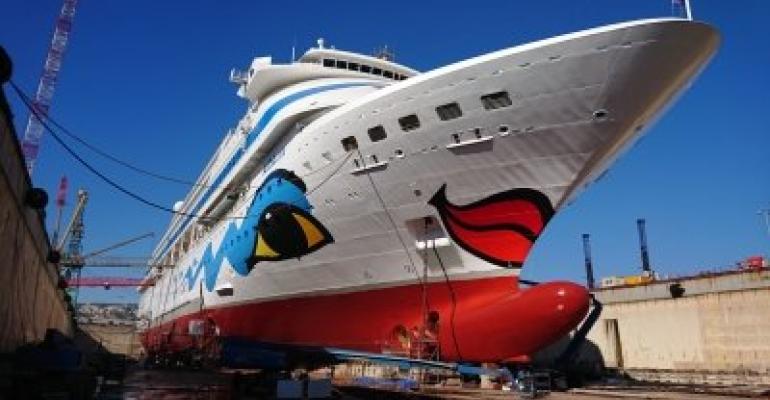AIDA Cruises decided to use the coating following successful test patches on a number of Carnival Corp. & plc ships.
Potential 10% reduction in fuel consumption
Nippon Paint’s research has shown that use of Aquaterras can potentially reduce fuel consumption by more than 10% compared to standard SPC antifoulants, due to its ultra-smooth surface and low friction attributes.
After surface preparation by full hydro-blasting during the vessel’s scheduled drydocking in February at CNdM Marseille, all underwater areas of AIDAcara’s hull were coated with Aquaterras. The coating was applied using standard equipment and without masking, a process that often extends the application time for silicone-type foul-release coatings.
'This application is the result of a longstanding project with Nippon Paint Marine to find an environmentally-sustainable way of reducing ships’ energy consumption,' said Jukka Ignatius, superintendent, innovation & energy management, Carnival Maritime, which is responsible for the technical and nautical operation of the AIDA ships.
Test patches over three years
'The feedback from joint testing and in-water inspections of test patches applied to our ships over the past three years has shown Aquaterras to be an effective antifouling that does not leach hazardous biocides into the water column,' Ignatius said. 'The expected reduced frictional resistance also helps towards reducing fuel consumption and, consequently, emissions, which is very much in keeping with our overall strategy of reducing the impact of operations on the marine environment.'
Aquaterras is a patent-protected micro-domain SPC that is based on a mix of hydrophilic and hydrophobic components, similar to the technology used to create artificial hearts and blood vessels where surfaces are required to suppress platelet aggregation. It contains no heavy biocidal pigments, active ingredients or silicone.
'We are delighted that a Carnival brand cruise line has become the sector’s first reference for Aquaterras,' said John Drew, director, Nippon Paint Marine.
Average hull roughness measured so far: 63µm
He added: 'After application, surface roughness measurements were as low as 40µm and averaged 63µm, but since Aquaterras is self-polishing, the overall hull roughness should become even lower as the vessel continues on its regular operations.'
Regular biocide-containing SPC antifoulants generally have an average hull roughness of around 100µm.
As AIDAcara is now operating its regular itinerary, AIDA Cruises and Nippon Paint Marine will continue to monitor the coating’s performance by studying the ship speed and propulsion power until the next scheduled drydocking.
Copyright © 2024. All rights reserved. Seatrade, a trading name of Informa Markets (UK) Limited. Add Seatrade Cruise News to your Google News feed.


